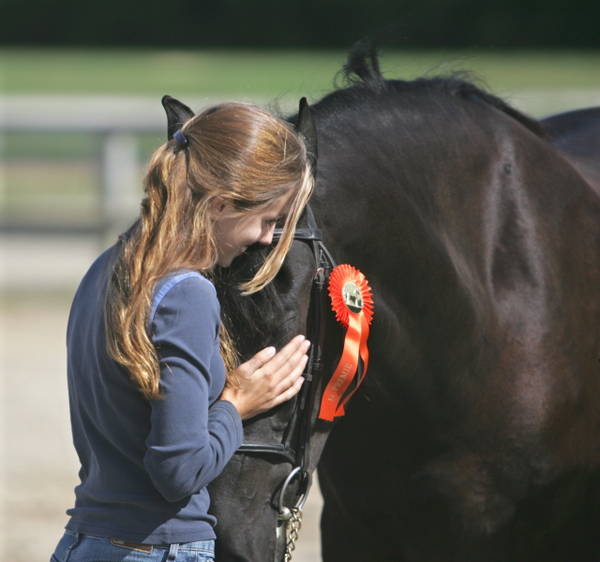For a Friesian horse, the keuring (judging) is one of the most important days of its life. The judging results, shown on a linear score sheet, will be added to the horses’ registration papers and will follow the horse through life. It impacts the value of the horse, its sire, and its dam. As a breeder, this score sheet is an asset to use to help with selecting a stallion for your mare. It is important to know how your mare compares to the breed standard and where you can improve by comparing it to a potential stallion’s score sheet.
What is a Linear Score Sheet?
A linear score sheet is used by the judges to assess how your horse compares to the breed standard. They are also collecting data for the Studbook to evaluate the success or failure of a breeding program. The score sheet uses 25 criteria.
In addition to the 25 criteria, horses are also given a score on 5 characteristics:
- Racial Type
- Frame
- Feet and Legs
- Walk
- Trot
Whether a horse receives a premium and moves up in the hierarchy of studbook depends on the final scores assigned by the judges for these 5 characteristics on the bottom of the form.
This final score will be put on the horse’s registration papers permanently. These scores are also used to evaluate the success of each approved stallion. This allows the registry to award permanent breeding approval to a stallion and gives breeders a way to evaluate the quality of that stallion’s offspring.
Premiums
Based on the average of the scores awarded by the judges, horses are either given premiums or not. The following table shows the average of the 5 scores required for the different inspection results:
- >7.5 Studbook with 1st premium Star
- ~7.0 Studbook with 2nd premium Star
- ~6-7 Studbook with 3rd premium
- ~6.0 Studbook with no premium
- <6.0 Remains in Foalbook
These scores are an average of the five summary scores, so a low score in one category can be offset by a higher score in another category, provided the low score is not too low. A horse with a score of 4 or less in any of the five criteria will not be promoted to the Studbook, nor will a horse with a score of 5 or less in any one of the five criteria enter into the Studbook.
Reading the Linear Score Sheet
At the very top of the page you will see the horse’s information: gender, name, height, sire and dam, location of the keuring, date of the score given and the judge.
After this information the elements the horse is judged on – characteristics, group, numbers and then characteristic – are seen. These elements are judged on a scale between 5-45, with a normal average of 25. Each element or characteristic is shown on the left, with the scale and score to the right. The breed ideal for each characteristic is shown in the shaded areas. This gives you a quick visual to understand how your horse is grading compared to the breed standard.
Each characteristic is grouped into one of the 5 main characteristic score groups listed above.
For example: Head, head and neck connection, neck position and length, hair and color are all components of Racial Type. In addition, each of these six criteria are “maximum,” rather than “optimal” characteristics, meaning that more is better. (Note the gray shaded boxes indicating the most desirable scores for each individual characteristic.)
Similarly, multiple faults will have a cumulative adverse impact on the score. Common faults that are fairly easy to see are: a too steep or too short croup, a straight shoulder or a back that is too long or hollow. The legs are also important, but may be more difficult for the average owner to evaluate. A fairly common fault of the hind legs is sickle hocks. Note that the score for the hind legs is at the midpoint. This is because the legs should not be too straight or too angled (sickle hocked). The degree of deviation of the legs from the desired conformation will determine how far from the ideal mark the horse should be scored.
The characteristics on the linear score sheet do change from time to time. The optimal score can change depending on what the registry and judging committee decide will improve the breed.
Evaluating Your Horse
It’s a good idea to take the blank linear scores sheet and do an extremely critical evaluation of your horse before sending it to keur. It will give you a much better idea of how your horse will fare at keur.
Want More Information?
The Keuring: Not for Sissies by Sally Lawing is a great resource if you are looking for more information on linear score sheets and keuring Friesian horses.
https://fhana.com/webinars/3127838-2015-linear-scores-and-other-information/
https://english.kfps.nl/Portals/0/Registration%20Regulations%20KFPS%20version%20najaar%202020.pdf

I’ve been around horses my entire life, but my Friesian journey started just over 20 years ago. Our horses have always been a part of our family. They have traveled with us as we relocated from Vermont to New York to Iowa and finally, to Arizona. I can’t wait to share our story with you!
Related
May 31, 2021
How to Understand a Friesian Keur Score From the Linear Score Sheet

Leave a Reply Cancel reply
@starlitridgefriesiansandfells
LET'S BE FRIENDS ON INSTAGRAM
[…] how to read and interpret a Linear score sheet in our Linear Score Sheet Explained […]